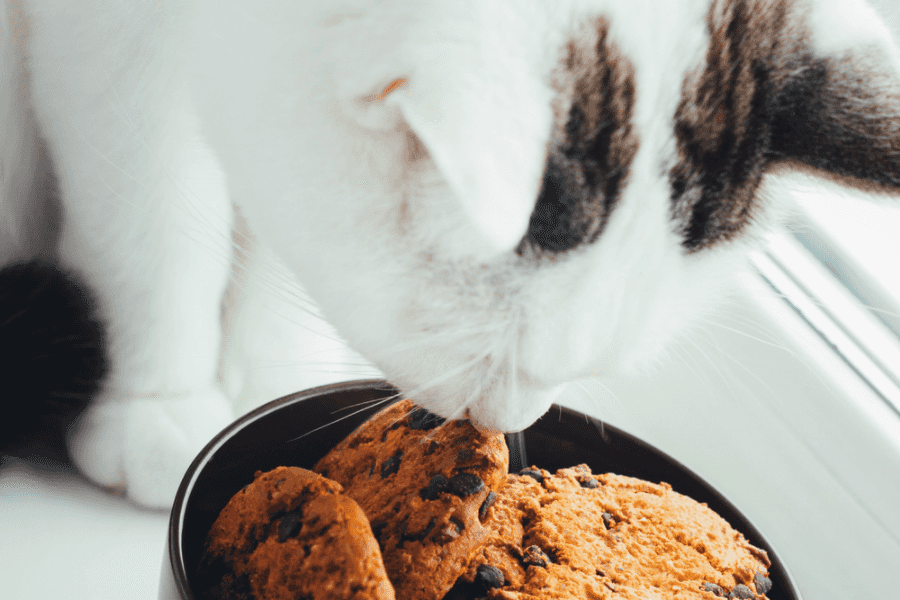What To Do If Cat Eats Chocolate? Vet Advice 🐱🍫

What to Do If My Cat Eats Chocolate? ![]()
As a pet owner, you may already know that chocolate is toxic to dogs, but did you know that it’s also harmful to cats?
Chocolate contains caffeine and theobromine, both of which are dangerous to cats. In large enough amounts, these compounds can be fatal.
In this article, we’ll discuss why chocolate is bad for cats, the symptoms of chocolate poisoning, and what to do if your cat eats chocolate.
Why is Chocolate Bad for Cats? 🍫🐾

Chocolate is made from the roasted seeds of the cacao plant. The caffeine and theobromine it contains are especially toxic to cats. These compounds are stimulants, and when absorbed in a cat’s body, they become highly toxic.
Dark and baker’s quality chocolate tends to be more toxic to cats because of higher levels of cocoa (and thereby more of the toxic compounds). If you’re wondering about other foods that might be harmful to your cat, check out our article on why cats can’t drink milk.
Symptoms of Chocolate Poisoning in Cats 🚨

If your cat has recently consumed chocolate, watch for the following symptoms:
- Diarrhea
- Vomiting
- Weakness
- Rapid breathing
- Elevated temperature
- Muscle rigidity
- Increased reflex response
- Seizures
- Cardiac arrest
- Coma
There are also some symptoms that you may not be able to identify, such as low blood pressure and a rapid heartbeat. These symptoms may only be discoverable by a veterinarian. If you’re concerned about other potential health issues, our article on warning signs your cat is crying for help might be of interest.
What to Do If Your Cat Eats Chocolate? 🆘

If you believe your cat has eaten chocolate, or you notice them exhibiting any of the symptoms listed above, take them to the veterinarian immediately. Your veterinarian may conduct a complete physical exam as well as various lab tests, including a urinalysis, an electrolyte panel, a chemical blood profile, and an ECG to see if your cat’s heart is showing any signs of abnormalities.
If your veterinarian diagnoses your cat with chocolate poisoning, they may induce vomiting to help prevent the dangerous ingredients in chocolate from causing further damage. Intravenous fluids can also be administered to help keep the cat hydrated, aid in more rapid metabolism, and dilute out the toxic ingredients of chocolate.
Once you bring your cat home, feed them a bland diet for a few days after receiving treatment, but always be sure to follow your veterinarian’s directions. You should also take the necessary steps to ensure your cat isn’t able to get into the chocolate again. Practice extreme caution giving your cat food meant for humans, as certain foods could contain chocolate without you realizing it.
Preventing Chocolate Poisoning in Cats 🚫🍫

The easiest way to prevent chocolate poisoning in cats is to keep chocolate treats locked away. This includes items that are easy to miss, like a chocolate-glazed donut left on the counter or bowls of unattended candy at Halloween.
Cats are curious, playful, and unpredictable, so it’s essential to keep all chocolate and cocoa-containing products out of their reach.
Healthy Treats for Your Cat 🍎🥕

While it’s not a good idea to give your cat too much ‘human’ food, there are a few appropriate snacks you can share with them now and then:
- Berries (remove stems and leaves)
- Ripe banana slices
- Carrots, green beans
- Diced, unsalted cooked turkey or chicken (without skin)
- A little bit of tuna (low sodium)
- Catnip tea or low-sodium chicken broth frozen into ice cubes
Even though your cat can’t enjoy a chocolate bar with you, there are several tasty treats you can offer from your kitchen, and a wide range of pet treats made just for your four-legged friend!
FAQ

Q: Can a small amount of chocolate harm my cat? A: Even a small amount of chocolate can be harmful to cats. Chocolate contains caffeine and theobromine, both of which are toxic to cats. The level of toxicity depends on the type and amount of chocolate consumed, as well as the size and weight of the cat. Dark and baker’s chocolate are more toxic to cats due to higher levels of cocoa. If you suspect your cat has consumed any amount of chocolate, it’s essential to seek veterinary care immediately.
Q: How long does it take for chocolate poisoning symptoms to appear in cats? A: Symptoms of chocolate poisoning in cats can appear within a few hours of ingestion. However, the onset of symptoms may vary depending on the type and amount of chocolate consumed, as well as the size and weight of the cat. Symptoms may include diarrhea, vomiting, weakness, rapid breathing, elevated temperature, muscle rigidity, increased reflex response, seizures, cardiac arrest, and coma. If you notice any of these symptoms in your cat, seek veterinary care immediately.
Q: What should I do if my cat ate chocolate? A: If your cat has eaten chocolate, take them to the veterinarian immediately. Your veterinarian may conduct a physical exam and various lab tests to determine the severity of the poisoning. Treatment may include inducing vomiting, administering intravenous fluids, and providing supportive care. Once your cat is back home, feed them a bland diet for a few days and follow your veterinarian’s directions. Take steps to prevent future access to chocolate and other toxic foods.
Q: Can I give my cat chocolate as a treat? A: No, chocolate is toxic to cats and should never be given as a treat. Chocolate contains caffeine and theobromine, both of which are harmful to cats. Even a small amount of chocolate can cause symptoms such as diarrhea, vomiting, weakness, rapid breathing, elevated temperature, muscle rigidity, increased reflex response, seizures, cardiac arrest, and coma. Instead of chocolate, offer your cat healthy treats like berries, ripe banana slices, carrots, green beans, diced unsalted cooked turkey or chicken, or catnip tea.
Q: How can I prevent chocolate poisoning in my cat? A: The best way to prevent chocolate poisoning in cats is to keep all chocolate and cocoa-containing products out of their reach. Store chocolate treats in locked cabinets or high shelves where your cat can’t access them. Be mindful of items that may contain chocolate, such as baked goods, candy, and chocolate-covered coffee beans. If you have guests, remind them not to feed your cat chocolate or leave chocolate items unattended. By taking these precautions, you can help keep your cat safe and healthy.
Conclusion

Remember, chocolate is toxic to cats, and even a small amount can be harmful. If you suspect your cat has consumed chocolate, seek veterinary care immediately. Your furry friend’s health and well-being are worth it!
Tags
Share
Table Of Contents
Related Posts
Quick Links

